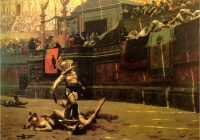Audience
From The Art and Popular Culture Encyclopedia
| Revision as of 22:26, 15 February 2013 Jahsonic (Talk | contribs) ← Previous diff |
Revision as of 22:27, 15 February 2013 Jahsonic (Talk | contribs) Next diff → |
||
| Line 1: | Line 1: | ||
| [[Image:Jean-Leon Gerome Pollice Verso.jpg|thumb|right|200px|''[[Pollice Verso]]'' by Jean-Léon Gérôme, 1872, is the immediate source of the "[[thumbs down]]" [[gesture]] in [[popular culture]]. It is owned by [[Phoenix Art Museum]].]] | [[Image:Jean-Leon Gerome Pollice Verso.jpg|thumb|right|200px|''[[Pollice Verso]]'' by Jean-Léon Gérôme, 1872, is the immediate source of the "[[thumbs down]]" [[gesture]] in [[popular culture]]. It is owned by [[Phoenix Art Museum]].]] | ||
| {{Template}} | {{Template}} | ||
| - | An '''audience''' is a group of [[person|people]] who participate in a [[Performance|show]] or encounter a [[work of art]], [[literature]] (in which they are called "readers"), [[theatre]], [[music]] (in which they are called "listeners"), [[video game]]s (in which they are called "players"), or [[academic]]s in any [[Media (arts)|medium]]. Audience members participate in different ways in different kinds of art; some events invite overt audience participation and others allowing only modest [[clapping]] and [[criticism]] and reception. | + | An '''audience''' is a group of [[person|people]] who [[participate]] in a [[Performance|show]] or encounter a [[work of art]], [[literature]] (in which they are called "readers"), [[theatre]], [[music]] (in which they are called "listeners"), [[video game]]s (in which they are called "players"), or [[academic]]s in any [[Media (arts)|medium]]. Audience members participate in different ways in different kinds of art; some events invite overt audience participation and others allowing only modest [[clapping]] and [[criticism]] and reception. |
| Media audience studies have become a recognized part of the curriculum. [[Audience theory]] offers [[scholar]]ly insight into audiences in general. These insights shape our knowledge of just how audiences affect and are affected by different forms of art. The biggest art form is the mass media. Films, video games, [[Radio programming|radio shows]], [[software]] (and hardware) and other formats are affected by the audience and its [[review]]s and recommendations. | Media audience studies have become a recognized part of the curriculum. [[Audience theory]] offers [[scholar]]ly insight into audiences in general. These insights shape our knowledge of just how audiences affect and are affected by different forms of art. The biggest art form is the mass media. Films, video games, [[Radio programming|radio shows]], [[software]] (and hardware) and other formats are affected by the audience and its [[review]]s and recommendations. | ||
Revision as of 22:27, 15 February 2013

|
Related e |
|
Featured: |
An audience is a group of people who participate in a show or encounter a work of art, literature (in which they are called "readers"), theatre, music (in which they are called "listeners"), video games (in which they are called "players"), or academics in any medium. Audience members participate in different ways in different kinds of art; some events invite overt audience participation and others allowing only modest clapping and criticism and reception.
Media audience studies have become a recognized part of the curriculum. Audience theory offers scholarly insight into audiences in general. These insights shape our knowledge of just how audiences affect and are affected by different forms of art. The biggest art form is the mass media. Films, video games, radio shows, software (and hardware) and other formats are affected by the audience and its reviews and recommendations.
In the age of easy Internet participation and citizen journalism, professional creators share space, and sometimes attention, with the public. American journalist Jeff Jarvis has said, "Give the people control of media, they will use it. The corollary: Don't give the people control of media, and you will lose. Whenever citizens can exercise control, they will." Tom Curley, President of the Associated Press, similarly said, "The users are deciding what the point of their engagement will be — what application, what device, what time, what place."
See also

